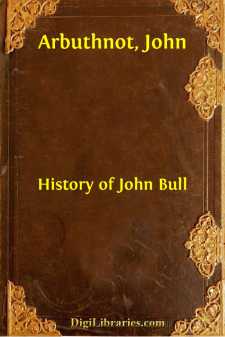Categories
- Antiques & Collectibles 13
- Architecture 36
- Art 48
- Bibles 22
- Biography & Autobiography 813
- Body, Mind & Spirit 141
- Business & Economics 28
- Children's Books 12
- Children's Fiction 9
- Computers 4
- Cooking 94
- Crafts & Hobbies 4
- Drama 346
- Education 46
- Family & Relationships 57
- Fiction 11826
- Games 19
- Gardening 17
- Health & Fitness 34
- History 1377
- House & Home 1
- Humor 147
- Juvenile Fiction 1873
- Juvenile Nonfiction 202
- Language Arts & Disciplines 88
- Law 16
- Literary Collections 686
- Literary Criticism 179
- Mathematics 13
- Medical 41
- Music 40
- Nature 179
- Non-Classifiable 1768
- Performing Arts 7
- Periodicals 1453
- Philosophy 64
- Photography 2
- Poetry 896
- Political Science 203
- Psychology 42
- Reference 154
- Religion 513
- Science 126
- Self-Help 83
- Social Science 81
- Sports & Recreation 34
- Study Aids 3
- Technology & Engineering 59
- Transportation 23
- Travel 463
- True Crime 29
History of John Bull
by: John Arbuthnot
Categories:
Description:
Excerpt
This is the book which fixed the name and character of John Bull on the English people. Though in one part of the story he is thin and long nosed, as a result of trouble, generally he is suggested to us as "ruddy and plump, with a pair of cheeks like a trumpeter," an honest tradesman, simple and straightforward, easily cheated; but when he takes his affairs into his own hands, acting with good plain sense, knowing very well what he wants done, and doing it.
The book was begun in the year 1712, and published in four successive groups of chapters that dealt playfully, from the Tory point of view, with public affairs leading up to the Peace of Utrecht. The Peace urged and made by the Tories was in these light papers recommended to the public. The last touches in the parable refer to the beginning of the year 1713, when the Duke of Ormond separated his troops from those of the Allies and went to receive Dunkirk as the stipulated condition of cessation of arms. After the withdrawal of the British troops, Prince Eugene was defeated by Marshal Villars at Denain, and other reverses followed. The Peace of Utrecht was signed on the 31st of March.
Some chapters in this book deal in like manner, from the point of view of a good-natured Tory of Queen Anne's time, with the feuds of the day between Church and Dissent. Other chapters unite with this topic a playful account of another chief political event of the time—the negotiation leading to the Act of Union between England and Scotland, which received the Royal Assent on the 6th of March, 1707; John Bull then consented to receive his "Sister Peg" into his house. The Church, of course, is John Bull's mother; his first wife is a Whig Parliament, his second wife a Tory Parliament, which first met in November, 1710.
This "History of John Bull" began with the first of its four parts entitled "Law is a Bottomless Pit, exemplified in the case of Lord Strutt, John Bull, Nicholas Frog, and Lewis Baboon, who spent all they had in a Law-suit." For Law put War—the War of the Spanish Succession; for lawyers, soldiers; for sessions, campaigns; for verdicts, battles won; for Humphry Hocus the attorney, Marlborough the general; for law expenses, war expenses; and for aim of the whole, to aid the Tory policy of peace with France. A second part followed, entitled "John Bull in his Senses;" the third part was called "John Bull still in his Senses;" and the fourth part, "Lewis Baboon turned Honest, and John Bull Politician." The four parts were afterwards arranged into two, as they are here reprinted, and published together as "The History of John Bull," with a few notes by the author which sufficiently explain its drift.
The author was John Arbuthnot, a physician, familiar friend of Pope and Swift, whom Pope addressed as
"Friend to my life, which did not you prolong,
The world had wanted many an idle song;"
and of whom Swift said, that "he has more wit than we all have, and his humanity is equal to his wit." "If there were a dozen Arbuthnots in the world," said Swift, "I would burn 'Gulliver's Travels.'"
Arbuthnot was of Swift's age, born in 1667, son of a Scotch Episcopal clergyman, who lost his living at the Revolution. His sons—all trained in High Church principles—left Scotland to seek their fortunes; John came to London and taught mathematics. He took his degree of Doctor of Medicine at St. Andrews in 1696; found use for mathematics in his studies of medicine; became a Fellow of the Royal Society; and being by chance at Epsom when Queen Anne's husband was taken ill, prescribed for him so successfully that he was made in 1705 Physician Extraordinary, and upon the occurrence of a vacancy in 1709 Physician in Ordinary, to the Queen....


